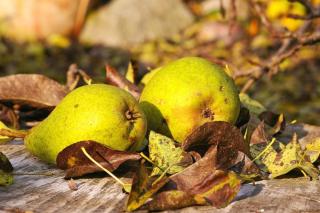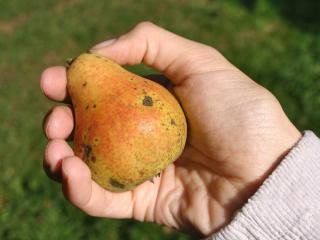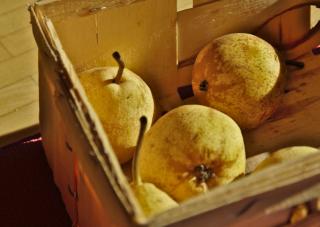

Starting in September, October and sometimes even November if the climate is mild enough, pears are harvested. Learn to store and keep them well.
Once you remove any that fall to the ground and must be quickly eaten, and those infected with diseases, worms or fungus, there still remains a sizeable portion of perfectly healthy pears that can be kept all winter long.
In proper storage conditions, pears will keep long enough for you to eat them until the end of winter, even the beginning of spring.
From harvest to storage, here is the procedure to follow for the best possible preservation of your pears.
Although all pears can keep for several months with proper storage conditions, some varieties stand out in that they keep more easily. A few hold well and are even tasty until spring.
Here are the pear tree cultivars that keep for a very long time since they mature very late:
 ‘Beurre Bachelier’
‘Beurre Bachelier’There are still many more, since the number of pear varieties is incredible!
This is an important step because it has a direct impact on how long pears keep.
No point in picking up fallen pears, they are very fragile and will only keep for a few days. You must eat them quickly or prepare culinary wonders such as pear liquor, Belle Helene pear dessert, pear yogurt cake, cinnamon cracker mousse with fried pears, or pear compote…
You must collect the pears directly from the tree, and they must be carefully chosen and picked in dry weather.
To ensure that each pear is pristine and doesn’t bear any trace of disease or fungus, the first step is to segregate the “1st class” pears.
 Spread the pears out, ensuring that they don’t touch to avoid spread of any possible later contamination.
Spread the pears out, ensuring that they don’t touch to avoid spread of any possible later contamination.These are the ones that are worth trying to keep.
Be strict: a single “sick” pear might contaminate its entire crate!

With this bit of advice, you should be able to keep your pears for many a long month, and thus savor fresh fruit in winter.
<!–silent
–>
Disinfect the surfaces you’ll be resting your “Class A” harvest, and let it dry before placing the pears on it.
PLEASE DO NOT HAVE THESE DISGUSTING PHOTOS OF EARWAX.
I was happily browsing pear-storage tips for my wonderful crop, and musing on the different suggestions, when I was assaulted by the revolting pictures of ear-wax. A more inappropriate advertisement alongside food is hard to imagine.
Hello Henrietta! I agree with you that the “ad lottery” sometimes serves us with “ewwww” ads! I’m very sorry because I don’t have any control over the type of ads. The most I can do (and believe me, I’m careful about this) is to block out any ads that lead to salacious or degrading sites. But there’s no way for me to say “block out ugly ads”. What you can do, though, is click on the corner of the ad, where it says “Ad choices”. There, you can select “Don’t show me this ad anymore”. Normally, from then on, you won’t see that particular ad on any of the websites you visit.
Thanks for your email which led me to your reply here. I know you can dismiss the ads, but by then the image has imprinted. That of course, is the idea.. Very unfortunate that there’s such limited influence on what is/isn’t shown.